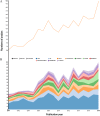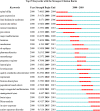Emerging trends and knowledge structure of epilepsy during pregnancy research for 2000-2018: a bibliometric analysis
- PMID: 31211023
- PMCID: PMC6557303
- DOI: 10.7717/peerj.7115
Emerging trends and knowledge structure of epilepsy during pregnancy research for 2000-2018: a bibliometric analysis
Abstract
Background: Epilepsy during pregnancy presents a unique set of challenges for pregnant women, the fetus, and the health care community. As research in this area advances rapidly, it is critical to keep up with the emerging trends and key turning points of the development of the domain knowledge. This study aimed to construct a series of science maps to quantitatively and qualitatively evaluate the intellectual landscape and research frontiers in the field of epilepsy during pregnancy research.
Methods: All publications were extracted from the Web of Science Core Collection database. Bibliometric analysis was used to analyze the scientific research outputs, including journals, countries/regions, institutions, authors (cited authors), intellectual base and research hotspots.
Results: A total of 2,225 publications related to epilepsy during pregnancy were identified as published between 2000 and 2018. The overall trend of the number of publications showed a fluctuating growth from 59 articles in 2000 to 198 in 2018. Neurology was the leading journal in the field of epilepsy and pregnancy research both in terms of impact factor score (8.055) and H-index value (77). The US retained its leading position and exerted a pivotal influence in this area. The University of Melbourne was identified as a good research institution for research collaboration. Prof. Pennell and Tomson have made great achievements in this area, and Prof. Tomson laid a foundation for the development of this domain. The keyword "neonatal seizures" ranked first in research hotspots, and the keyword "autism spectrum disorders (ASD)" ranked first in research frontiers.
Conclusions: Epilepsy during pregnancy is a fascinating and rapid development of subject matter. A more recent emerging trend focused on comprehensive management of pregnant and lactating women, evaluation of the safety and efficacy of newer antiepileptic drugs. The keywords "management issue," "brain injury," "meta-analysis," "in utero exposure," and "ASD" were the latest research frontiers and should be closely observed.
Keywords: Antiepileptic drugs; CiteSpace; Epilepsy; Pregnancy; Scientometrics; Visualization.
Conflict of interest statement
The authors declare that they have no competing interests.
Figures







References
-
- Bobo WV, Davis RL, Toh S, Li DK, Andrade SE, Cheetham TC, Pawloski P, Dublin S, Pinheiro S, Hammad T, Scott PE, Epstein RA, Jr, Arbogast PG, Morrow JA, Dudley JA, Lawrence JM, Avalos LA, Cooper WO. Trends in the use of antiepileptic drugs among pregnant women in the US, 2001-2007: a medication exposure in pregnancy risk evaluation program study. Paediatric and Perinatal Epidemiology. 2012;26:578–588. doi: 10.1111/ppe.12004. - DOI - PMC - PubMed
LinkOut - more resources
Full Text Sources
Research Materials

